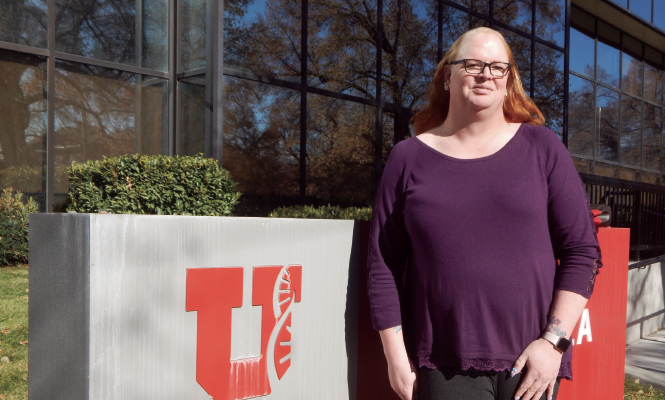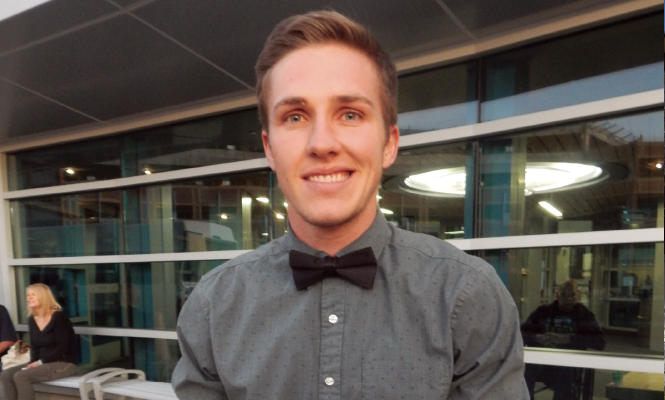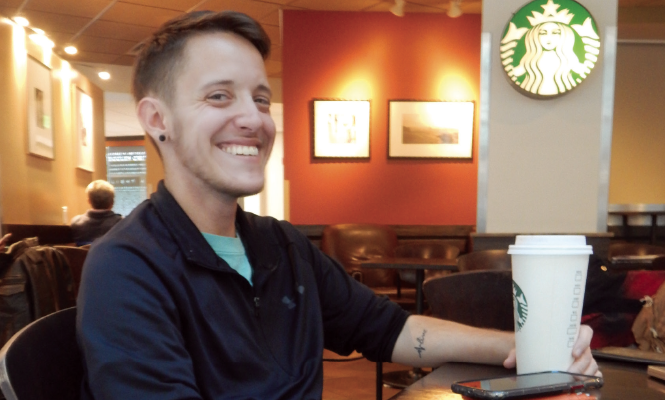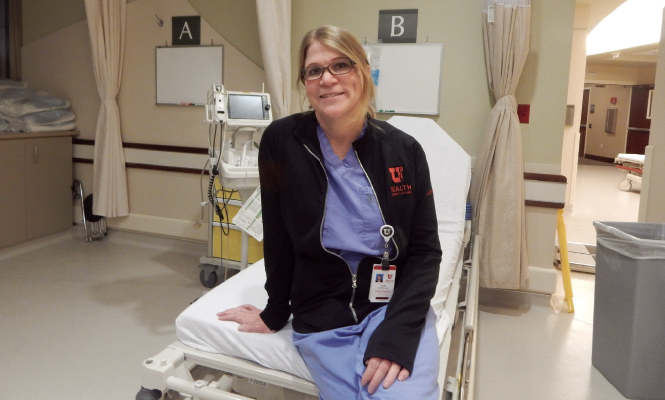The Journey of Becoming You
How 'gender-affirming' philosophy and multidisciplinary care at the University of Utah's Transgender Health Program helps patients feel whole.
By Peter Holslin @PeterHolslinWhen Josie Jesse sat down for a consultation with a surgeon at the University of Utah Hospital last year, she had some questions.
Well, actually—she had a lot of questions.
"I looked at him and I said, 'You might want to take a seat,'" Josie, a 46-year-old transgender woman who lives in the South Jordan community of Daybreak, recalls. "He goes, 'No, I'm OK.' Well, about 25 minutes later, he finally sat down. And it was a little over an hour later that we finally finished."
Josie (who doesn't offer her last name in interviews for safety reasons) was meeting with Jeremy B. Myers, chief of the Division of Urology at University Hospital, who works as part of a grassroots hospital initiative called the Transgender Health Program. Josie was about to be the first patient in Utah to undergo a vaginoplasty, a complex procedure in which reconstructive surgeons use tissue from the penis to create a vagina for a transfeminine patient.
"I wanted to make sure that they knew what they were doing," Josie says.
Surgical procedures to help peoples' bodies align with their gender identities have been around since the early 20th century. But it's only been in the past few years that legal changes, medical advances and rising cultural visibility for the trans community have allowed for a growth in comprehensive health care options. At the U, the Transgender Health Program has risen to the top of the field, providing a range of medical services that play a central role in what can be lifelong journeys for those seeking to live their truth.
"We feel very passionate about taking care of this very vulnerable patient population," Cori Agarwal, the program's director, tells City Weekly. "This is a group of people who struggled their whole lives—gender dysphoria, being born in the wrong body essentially, is really hard. Through their childhood, through their adolescence, through their early years, it's a battle for them to find doctors that listen to them and who know how to take care of them properly."
Transgender patients at the U have invested heavily—emotionally, physically and financially—to seek out surgeries and medication that will aid them through their transition. They've overcome enormous obstacles and trauma just to arrive in the hospital room. It's often a matter of life or death that they have the body that fits with who they are.
But even with great support, some emphasize that the process of transitioning is never easy.
'AN INTERNAL FIGHT'
In an interview with City Weekly at a bustling downtown coffee shop, Josie towers over everyone in the room, standing tall at 6-foot-2. She's wearing a purple blouse, her long fingernails painted in colorful pastel designs, her red hair flowing past her shoulders and her nose pierced with a tiny, ruby-red stud.
Since coming out as transgender on Aug. 28, 2016, she says she's been spat on, kicked, hit and refused service at clothing stores and restaurants. But people have also approached her with questions, curious to know more. After living in the closet for more than 40 years, she's now an open book, eager to carve out a career as a public speaker under the motto "Real Talk with Josie."
"I've known my entire life I was a girl," she says. "I've never understood why I had a penis and why I developed as a boy and my brain always told me I was a girl. It was always an internal fight."
She was given a male name at birth (she asked that City Weekly leave her birth name or "dead name" out of this article, as she has since legally changed it) and grew up in a sprawling Christian family in Montana. Their free time centered around church, and as Josie got older, she tried her best to uphold the standards of masculinity imparted to her by her mother.
She got married and had kids. She enlisted in the U.S. Air Force and was deployed to far-off locales in the 1990s, helping out with hurricane relief in Florida, and taking fire from militants while offloading onto landing zones from moving aircraft in Somalia. These were the years of the dysfunctional "Don't Ask, Don't Tell" policy, in which service-members risked their lives for their country but also risked being kicked out of the military if they happened to get outed as LGBTQ.
As the years went on, Josie finally had enough.
"I started researching a little bit, trying to figure out who I was," she says. "I kinda knew the word transgender, but didn't know what transgender was."
FINDING THE WORDS
Seeking out good health care can be a daunting task for many transgender individuals—and one of the biggest challenges is overcoming the stigma that makes them feel like they shouldn't be seeking out that help in the first place. From 1980 until 2013, the American Psychiatric Association classified gender dysphoria as a "gender identity disorder" in the Diagnostic and Statistical Manual of Mental Disorders, pathologizing the condition in a handbook that sets national standards for clinicians, insurance companies and policymakers.
Many insurance providers have long rejected coverage for medications and procedures like "top surgery"—i.e., removing a transgender man's unwanted breasts and recreating the nipples and skin to give the chest a more masculine character. Procedures like these are often denied on the grounds that they are merely "cosmetic," even though transgender patients consider them vital for their mental and physical health.
In 2015, the National Center for Transgender Equality and the National LGBTQ Task Force conducted a national survey and found that 40% of the respondents attempted suicide at some point in their lives—an average that's nine times greater than suicide attempts in the general U.S. population. A third of the respondents also reported having at least one negative experience related to being transgender while seeking treatment from health care providers. Nearly a quarter didn't seek out health care when they needed it out of fear of being mistreated or discriminated against.
"When a trans person needs a doctor, they often put it off as long as possible," says Ian Giles, founder of the Orem-based nonprofit Genderbands, which provides grants to members of the trans community to help them offset the costs of transition-related medical procedures.
"When they cave, they typically spend a very long time Googling and asking their friends and online groups where to find a trans-friendly doctor," Giles, a nonbinary transman who uses they/them pronouns, explains. "Often no names are given. Sometimes you get lucky and get a name. Even luckier if insurance will cover it. Then there's the making of the appointment—the trans person could get misgendered on the phone based on their voice or name and might have to explain name discrepancies in old medical records. Or even worse, they have to explain why they are making the appointment and are barraged with questions when this doesn't make sense."
Another big challenge, though, is just knowing what words to use. For some, it takes years for them to get the information and clarity they need to figure out what they're going through.
"I didn't have the vocabulary that most people are exposed to," Jason Lindow, a 28-year old high school teacher who grew up in the tiny Utah pioneer town of Spring City, tells City Weekly. As a teenager, Lindow knew he was attracted to women. He presented masculine by wearing boy's T-shirts and jeans. He first heard the word "lesbian" when he was 18, and identified that way, until he began his own transition as a transgender man about three years ago, after being inspired by two trans students at the school where he teaches.
"Getting to know them and then sitting with my own journals and photo albums, my own feelings, I became aware of the word I'd been really looking for to describe how I'd been feeling," Lindow says. "I was 26, and I started looking into what options I had for transitioning."
MOVING FORWARD
The first gender-affirming medical procedures emerged in the early 1900s. The German sexologist Magnus Hirschfeld, born in 1868, was an early champion of LGBTQ rights, and he studied transgender patients' struggles as part of what at the time represented groundbreaking research on sexuality and gender.
Hirschfeld's most iconic patient was Lili Elbe, a Danish artist later immortalized in the 2015 film The Danish Girl. Elbe was born with male genitalia but spent 20 years presenting as a woman, and she sought a medical transition through a series of procedures to remove the testicles and later—in surgeries overseen by a different doctor—to implant ovaries and a uterus.
The surgeries were sadly not successful: Elbe died of heart failure as a result of the uterine transplant in 1931. Hirschfeld, who himself faced enormous controversy for his work, was forced into exile by the Nazis and eventually died of a heart attack in 1935. The term he coined to describe gender dysphoria, "transvestite," is now considered outdated and offensive; much of the way the LGBTQ community thinks and talks about the topic has evolved enormously since those early years. But these efforts nevertheless served as a beginning for what's become a decades-long process in advancing ways to provide medical care to the trans community.
"I think people, even back in the '30s, were thinking about this and they were trying to come up with ways to help people who had these issues with gender identity," says Isak Goodwin, a plastic surgeon at the U, who works alongside doctors Agarwal, Myers and James Hotaling on the Transgender Health Program's vaginoplasty procedures. "Now, we have much more of a public dialogue about gender identity and I think that has really helped facilitate moving forward."
LEARNING THE ROPES
The idea of a Transgender Health Program first took root not long after Agarwal arrived at the University Hospital in the late 2000s. A plastic and reconstructive surgeon, she has specialized over the years in repairing and reconstructing body parts for cancer survivors, burn victims and other patients seeking relief from damage or disfigurement.
One day, a patient approached Agarwal about the possibility of doing top surgery—a procedure that involves an overlapping set of techniques and skills. Agarwal didn't know anything about it at the time, and soon she found that top surgery was part of a still-emerging field of what she and other surgeons refer to as "gender-affirming" surgery (a term they feel is more pro-patient compared to other antiquated terminology).
"People were doing it, but only a couple in the country and they weren't sharing their techniques," Agarwal says during an interview at the University Hospital Starbucks on a recent, characteristically busy afternoon for the in-demand surgeon.
After researching the procedure, Agarwal was able to successfully operate on the patient. As the years went on, she would sit down for consultations with more and more trans patients, who would request that she perform top surgeries for them as well. Eventually, she built a reputation as an expert, doing intensive research and teaching the procedure to medical students in live surgeries conducted at institutions like Mount Sinai Medical Center in New York.
But she also realized that specializing in just one thing wasn't enough.
'WE NEED A PROGRAM'
In recent years, celebrities like Laverne Cox and Caitlyn Jenner have brought more visibility to trans issues. The medical field has gradually gotten more receptive to transgender patients' needs as well: In 2014, the U.S. Department of Health and Human Services lifted a long-held policy that barred Medicare from providing coverage for trans, nonbinary and gender-nonconforming medical issues. But members of the trans community often still rely on internet research and word-of-mouth to find good doctors, and only a handful of research- and university-based medical institutions provide comprehensive care.
"It was very difficult for the patients to find us," Agarwal recalls, as more attention started drawing to the services coming together at the U. "We started to say, 'We need a program.'"
Three years ago, the U authorized Agarwal and her fellow medical practitioners to create a name for the Transgender Health Program. The program has yet to open an official office or headquarters, but a core group of about 15 doctors, surgeons and other health care providers work alongside a network of dozens of other professionals to provide a range of services for adults and kids, including hormone therapy, laser hair removal and affirming surgery.
The program has a coordinator, Ariel Malan, involved in outreach efforts. A "patient navigator," Elliot Camarillo, helps guide new patients to the services they need. The U also puts on free seminars every month at the Utah Pride Center about different aspects of transgender health. The next one, happening Thursday, Dec. 19, covers hormone- and voice therapies.
"I think of it like grassroots—the patients came to us and then we came to the administration," Agarwal says. "There's a need for this full, multidisciplinary care for people. We need hormones. We need primary care. We need adolescent care."
Patients who have worked with the program say they feel empowered and dignified from the care they've received. Eli Blevins, a transgender man originally from Tennessee, says he marked down the calendar date on his phone for his top surgery in May 2018 with the note, "Time to get something off my chest!" The day after the surgery, he surrounded himself with pillows to ease the waves of muscle pain that came during the recovery. Now, he's making plans to get a chest tattoo.
"It's kind of funny, because the tattoo is going to cost more than the top surgery," he says.
Still, there's been more to learn. And last year, surgeons Agarwal, Goodwin, Myers and Hotaling broke new ground by conducting Utah's first vaginoplasty.
'MORE THE SAME THAN WE THINK'
Josie keeps a list of dates marking her transition filed away in her mind. April 3, 2016, for instance, was the day she decided to live and begin her transition, rather than lose her life to suicide. A few weeks later, on her birthday, she took her first hormone treatment. She officially came out as transgender to her friends and family that August. The following spring, a year to the date when it all began, she appeared before a judge to secure her legal name and gender change. In August 2017, a year to the day after coming out, she got breast augmentation surgery. Then she got the vaginoplasty in April 2018.
"I like to say that she's a pioneer, in a true Utah way," Goodwin says.
The four surgeons spent a year-and-a-half in training for the procedure. Agarwal and Goodwin are specialists in plastic surgery; Myers and Hotaling masters of urology. Together, they share a foundational knowledge of anatomy and the principles involved in reconstructive procedures. But prior to Josie's operation, they hadn't done the surgery themselves. So they read numerous academic papers on the topic and fanned across the country to train with other specialists, who welcomed them into operating rooms to observe and take notes.
According to Goodwin, the procedure involves creating space for a vaginal canal in the area between the prostate and the rectum, and deconstructing the penis to use its various structures to mirror the functions of a vagina. The process is made easier with hormone therapy, but it also reflects similarities shared by the male and female sexual organs.
"We're all way more the same than we think, in that we have structures that are the same structure, just some are bigger and some are smaller," Goodwin says. "For example, the male scrotum is homologous with the female labia majora, and the head of the penis—the glans of the penis—is homologous with the head of the clitoris."
On average, the surgery takes between five to seven hours. In our interview at the coffee shop, Josie whips out her phone to show off pictures from her own operation. The images are as squeam-inducing to an outsider as you could imagine—there's a lot of blood, a lot of unfamiliar medical equipment. Testicles sit on a tray, unattached to a human body. Genital parts are shown at various, highly sensitive angles. For Josie, going through processes like these is akin to what happens when a moth transforms into a butterfly.
"If you ever understand the metamorphosis, it's actually a very ugly, painful process inside that cocoon," she muses.
WHAT HAPPENS NEXT
For the first month after her surgery, Josie recovered with the help of a network of friends in her cozy corner of South Jordan. They signed up to drive her to appointments, take care of her laundry and bring food. Now, more than a year later, Josie is pleased with how her vagina came together on the operating table.
"Function-wise, it's absolutely amazing," she says, flashing a wry smile. "I've told several of my guy friends, 'I'm so sorry. You have no idea what you're missing out on.'"
The experience raises an important question—what next? When you take enormous risks to finally become the person you really are, the world can open up in ways that can be beautiful but also extremely daunting.
"It's scary for a lot of people, because suddenly the rules and the box that we all live in—it's gone," Andi Crenshaw, a local transgender woman and drag performer, says. "It's just freedom as far as the eye can see, and they're like, 'Well, what do I do with all this freedom? Who am I going to be? What kind of woman am I? Am I punk? Am I sophisticated? Am I classy? Am I a little slutty?' There's so much more, because before you were just unhappy."
Josie says there have been times during her transition where she's felt lost as she's plotted a way forward. But she has a bright future to think about, and even with the challenges it seems she's where she wants to be.
"I still don't really have the words to describe the feeling of being whole, being complete," Josie says. "I still stand in front of the mirror naked at times and just cry, because I finally just see me." CW
More by Peter Holslin
-
Rebel Spirits
A Facebook group draws a bullseye on the DABC while calling for alcohol reforms.
- Dec 11, 2019
-
Say Their Names
Transgender Day of Remembrance ceremony in the Capitol honors victims of transphobic violence.
- Nov 21, 2019
-
Bad Banners
A year after the city launched a poll to reboot its flag, Salt Lakers are still waiting for a tattoo-worthy design.
- Nov 20, 2019
- More »
Latest in Cover Story
Readers also liked…
-
Forget the family pedigree—Robert F. Kennedy Jr should not be the next president of the United States
Trojan Horse
- Jun 21, 2023
-
Women decry harassment and toxic culture at St. George auto dealership
Men at Work
- Oct 11, 2023









